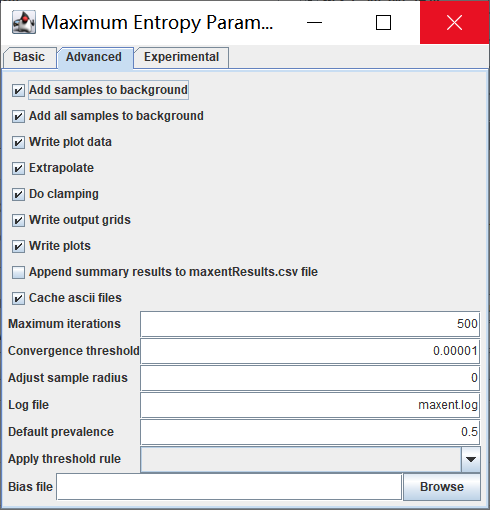源程序下载
https://biodiversityinformatics.amnh.org/open_source/maxent/
源代码
https://github.com/mrmaxent/Maxent
使用手册
https://clp-foss4g-workshop.readthedocs.io/en/latest/maxent_install.html
文献引用
Steven J. Phillips, Robert P. Anderson, Robert E. Schapire,
Maximum entropy modeling of species geographic distributions,
Ecological Modelling,
Volume 190, Issues 3–4,
2006,
Pages 231-259,
ISSN 0304-3800,
https://doi.org/10.1016/j.ecolmodel.2005.03.026.
分布数据:
通过全球生物多样性信息服务网络平台(Global Biodiversity Information Facility, GBIF)物种分布信息数据下载,国内外公开发表文献查阅及实地调查的方式,以获取黄野螟在全球分布点数据
黄野螟的数据为:
https://www.gbif.org/species/1890031
Citation:
GBIF.org (10 June 2023) GBIF Occurrence Download https://doi.org/10.15468/dl.m2srts
环境数据:
从世界气象数据库(Worldclim, https://www.worldclim.org/)下载全球气候数据,该数据共包含 1970—2000 年的 19 个生物气候变量,版本为 Version 2.0,空间分辨率为 5 min(~10 km)。
https://www.worldclim.org/data/worldclim21.html
Citation:
Fick, S.E. and R.J. Hijmans, 2017. WorldClim 2: new 1km spatial resolution climate surfaces for global land areas. International Journal of Climatology 37 (12): 4302-4315.
地图数据:中国国界和省级行政区划图矢量
底图(1∶4 000 000)来源于国家基础地理信息中心(http://www.ngcc.cn/ngcc/)。
SDMTools
[1] Vanderwal J , Falconi L , Januchowski S ,et al.SDMTools: tools for processing data associated with species distribution modelling exercises[J]. 2012.
Bioclimatic variables
Bioclimatic variables are derived from the monthly temperature and rainfall values in order to generate more biologically meaningful variables. These are often used in species distribution modeling and related ecological modeling techniques. The bioclimatic variables represent annual trends (e.g., mean annual temperature, annual precipitation) seasonality (e.g., annual range in temperature and precipitation) and extreme or limiting environmental factors (e.g., temperature of the coldest and warmest month, and precipitation of the wet and dry quarters). A quarter is a period of three months (1/4 of the year).
They are coded as follows:
BIO1 = Annual Mean Temperature
BIO2 = Mean Diurnal Range (Mean of monthly (max temp - min temp))
BIO3 = Isothermality (BIO2/BIO7) (×100)
BIO4 = Temperature Seasonality (standard deviation ×100)
BIO5 = Max Temperature of Warmest Month
BIO6 = Min Temperature of Coldest Month
BIO7 = Temperature Annual Range (BIO5-BIO6)
BIO8 = Mean Temperature of Wettest Quarter
BIO9 = Mean Temperature of Driest Quarter
BIO10 = Mean Temperature of Warmest Quarter
BIO11 = Mean Temperature of Coldest Quarter
BIO12 = Annual Precipitation
BIO13 = Precipitation of Wettest Month
BIO14 = Precipitation of Driest Month
BIO15 = Precipitation Seasonality (Coefficient of Variation)
BIO16 = Precipitation of Wettest Quarter
BIO17 = Precipitation of Driest Quarter
BIO18 = Precipitation of Warmest Quarter
BIO19 = Precipitation of Coldest Quarter
This scheme follows that of ANUCLIM, except that for temperature seasonality the standard deviation was used because a coefficient of variation does not make sense with temperatures between -1 and 1).
To create these values yourself, you can use the ‘biovars’ function in the R package dismo.


tif文件批量转换成asc格式文件,可以通过R语言来实现,但是如果安装了arcgis就直接用arcgis的tool来做就行了,还需要下载SDM tools非常好用。



点击run开始执行

将生成的结果asc文件直接拖入arcgis即可

解决这个问题的时候
计算class的tool在 工具箱\系统工具箱\Data Management Tools.tbx\栅格\栅格属性\计算统计数(caculate statistics)

| Variable | Percent contribution | Permutation importance |
|---|---|---|
| wc2.1_5m_bio_18.tif | 60.7 | 20.5 |
| wc2.1_5m_bio_13.tif | 22.5 | 31.7 |
| wc2.1_5m_bio_3.tif | 3.7 | 9.9 |
| wc2.1_5m_bio_4.tif | 2.4 | 8 |
| wc2.1_5m_bio_7.tif | 1.8 | 1.7 |
| wc2.1_5m_bio_2.tif | 1.8 | 7 |
| wc2.1_5m_bio_16.tif | 1.8 | 0 |
| wc2.1_5m_bio_17.tif | 1.2 | 8.7 |
| wc2.1_5m_bio_14.tif | 1 | 2.4 |
| wc2.1_5m_bio_6.tif | 0.9 | 1.8 |
| wc2.1_5m_bio_11.tif | 0.6 | 1.3 |
| wc2.1_5m_bio_15.tif | 0.6 | 2.3 |
| wc2.1_5m_bio_12.tif | 0.5 | 2.7 |
| wc2.1_5m_bio_8.tif | 0.2 | 0.7 |
| wc2.1_5m_bio_1.tif | 0.1 | 0.2 |
| wc2.1_5m_bio_19.tif | 0.1 | 0.5 |
| wc2.1_5m_bio_9.tif | 0.1 | 0.4 |
| wc2.1_5m_bio_10.tif | 0 | 0.1 |
| wc2.1_5m_bio_5.tif | 0 | 0 |
然后再使用部分的biovar做训练。
如果要对全国的地图进行裁剪,需要先下载国界,省界,还有九段线的shp文件,使用arcgis的mask功能进行裁剪

https://www.bilibili.com/video/BV1dY41157i5